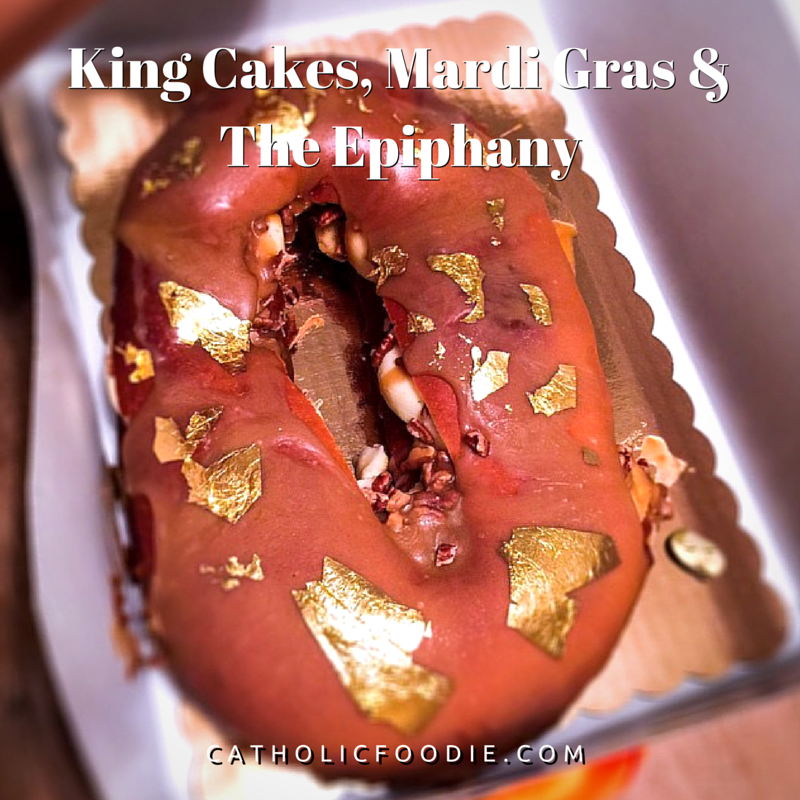King Cakes, Mardi Gras and the Epiphany

From Wednesday’s show… King Cakes, Mardi Gras and the Epiphany… including the history of the King Cake, King Cake traditions, the Epiphany and how God meets us in the ordinariness of daily life AND does something extraordinary in us… AND my recipe to make a King Cake right in your very own kitchen. All this and more on The Catholic Foodie Show!
LISTEN TO THE SHOW
Click the Play button below to listen to the show. You can always right-click and save-as to download the show for listening later.
King Cake Traditions & Carnival Season
King Cake Recipe
INGREDIENTS
- 2 packets of active dry yeast (4½ teaspoons)
- ½ cup granulated sugar
- 1-1/2 sticks of butter, melted (Kerrygold)
- 1 cup warm milk (about 110 F)
- 5 large egg yolks, room temperature
- 4½ cups of all-purpose flour (King Arthur)
- 2 teaspoons kosher salt
- 1 teaspoon freshly grated nutmeg
- 1 teaspoon grated lemon zest
- 1 teaspoon oil (regular olive oil)
- 1 lb. cream cheese, room temperature
- 3½ cups confectioner’s sugar
- 1 plastic king cake baby or pecan half
- 5 tablespoons milk, room temperature
- 3 tablespoons fresh lemon juice
- Purple, green, and yellow food coloring
INSTRUCTIONS
FOR THE DOUGH
- Combine the yeast and the granulated sugar in the bowl of a stand mixer fitted with a dough hook. If you don’t have a stand mixer, don’t worry, you can do the same thing by hand in a large mixing bowl.
- Add melted butter and warm milk and beat for one minute at medium-low speed.
- With the mixer still running, add the egg yolks and beat for another minute.
- Add the flour, salt, nutmeg, and lemon zest and beat until everything is incorporated. Increase the speed to high and beat until the dough pulls away from the sides of the bowl and forms a ball (or starts to climb up the dough hook). As with any dough, you may have to add water (a tablespoon at a time) or more flour to get the right results.
- Remove the dough from the bowl and, using your hands, form it into a smooth ball. Using regular olive oil (not extra virgin), lightly oil a large mixing bowl. Place the dough in the bowl, rolling it around to coat it on all sides with oil. Cover the bowl with plastic wrap and set aside in a warm, draft-free place for about 2 hours. You want the dough to double in size.
FOR THE FILLING
- In a large mixing bowl, combine the cream cheese and ½ cup of confectioner’s sugar. Blend using a fork or an electric mixer on low speed. Set aside.
AFTER THE DOUGH HAS DOUBLED IN SIZE
- Turn the dough out onto a lightly floured surface. Using your hands or a rolling pin, roll it out into a rectangle about 30 inches long and 6 inches wide.
- Take the cream cheese filling and spread it out lengthwise over the bottom half of the dough.
- Flip the top half of the dough over the filling and seal the edges with your fingers, pinching the dough together.
- Shape the dough into a cylinder and place it on a baking sheet (I use a round pizza stone) seam side down. Shape it into a ring and pinch the ends together, doing your best so that there’s no visible seam.
- Cover the ring with plastic wrap (or a clean kitchen towel) and set aside in a warm, draft-free place. Let the dough rise until doubled in size (about 45 minutes).
- Preheat oven to 350 F.
- Once the cake has doubled in size, remove the plastic wrap or towel and brush the surface of the cake with 2 tablespoons of milk.
- Place cake in oven and bake 25 to 30 minutes, until it is golden brown.
- Remove from the oven and place the cake on a wire rack so that it can cool completely.
- When it is completely cooled, insert the plastic baby, or pecan half, from the bottom of the cake.
FOR THE ICING
- In a mixing bowl, combine 3 cups of confectioner’s sugar, 3 tablespoons of milk and 3 tablespoons of lemon juice. Stir well with a fork. Once it is well-blended, divide the icing into three small bowls. Carefully, one drop at a time, add a different colored food coloring (purple, green and yellow) to each of the bowls, stirring in each drop to achieve the desired colored icing.
- Once the cake is completely cooled, the icing can be poured over the cake with a spoon, carefully alternating the colors around the king cake. See photo for an example.